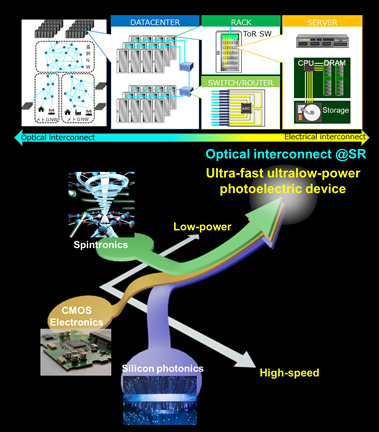Technology theme: Innovative device technologies to achieve ultra-high level information processing in the age of trillion sensors (TSensors)
In Society 5.0, new values are expected to be created as every sort of information is acquired by sensors, and analyzed by AI. At that time, AI is required to analyze huge amounts of information, which is orders of magnitude larger than before, as the number of sensors increases. In order to realize this ultra-high level information processing, technological innovation regarding information processing on the cloud side that consolidates information and on the edge side which installs sensors to generate information is required.
Specifically, the increase in electrical resistance due to the miniaturization of electrical wiring and the delay due to parasitic capacitance limit the speeding up and low power consumption on the cloud side. Competition for technological development to replace as much wiring in computers as possible with optical wiring is intensifying all over the world. However, even if optical wiring can be introduced, it is necessary to convert optical signals into electrical signals to perform calculation processing, and further speeding up of the optical-electrical conversion interface equipped with buffer memory, and lower power consumption are thought to largely contribute to the sophistication of information processing. On the other side, there is also a limit in securing power source in a moving object such as a living body monitor or self-driving vehicle, and if further reduction of power consumption cannot be achieved, the information processing required on the edge side will not be complete.
The JST-Mirai program started R&D of innovative thermoelectric conversion technology as the power source for driving sensors from FY2019. In this fiscal year, it plans to start R&D of innovative information processing hardware technology using various technologies that realize ultra-high level information processing in the era of Trillion (1 trillion) sensors, such as technologies far exceeding conventional photonics and spintronics, and technologies combining them.
Innovation of Photoelectric Technologies using Spintronics

| R&D Period | 2020.11- |
|---|---|
| Grant Number | JPMJMI20A1 |
| Project Summary | Summary |
Summary:
Information and communication technology plays a critical role in realizing Society 5.0. The development of high-speed, widebandwidth, and low-power devices is all the more urgent to achieve sustainable information processing systems.
In high-end information processing systems such as switches and routers in large-scale data centers, I/O bottleneck has become a central challenge, awaiting the creation of ultra-fast and ultra-low power photoelectric devices. Specifically, the long electrical interconnects and the integration-limit of CMOS circuits hinder the simultaneous realization of high-speed performance and low-power consumption. To overcome this difficulty, we develop innovative photoelectric technologies, intermediating electrical signals and optical signals by spintronics to achieve a highly functional I/O device.

R&D Team
[Leading Institution]
The University of Tokyo
[Collaborators]
The University of Tokyo, Nihon University, AIST, Tohoku University, Saitama University, The University of Osaka,
JSR Corporation, Nitto Denko Corporation, ROHM Co., Ltd., ALPS ALPINE CO., LTD., JX Advanced Metals Corporation
|
Affiliation and job title should automatically appear from the information that a researcher registered with researchmap.
Data may be outdated or undocumented. When there is not a connection via the internet, data are not displayed. |


